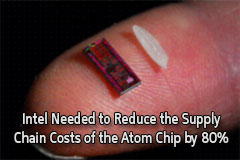What was immediately recognized as a game changer was that the usual cost-service tradeoff wouldn’t work for the Atom. Service had to stay the same or improve, while ratcheting costs dramatically down.
To do that, the team recognized it had to have very few constraints in its thinking – the only “must do” the team really operated on was that Intel’s own factories, or “fabs,” had to be used to produce the chip.
 Focus on Inventory Focus on Inventory
Computer chips are small, and have an extremely high value to weight ratio. Therefore, there were only marginal opportunities to improve distribution costs, and even less in transportation.
At the same time, inventory carrying costs represented the preponderance of total supply chain costs.
For its traditional chips, Intel operated on about a nine-week total order cycle time with its customers. During the first seven weeks of that time, there were, generally, many order changes from the customer – over 90% of the orders were changed after the initial order was placed, Kellso said.
This also led to inventory builds, as the factories spent a long time optimizing and re-optimizing the factory schedule, in part dealing with all the customer change orders.
However, those order changes dropped to single digits in the last two weeks – as Intel’s customers froze their own MRP runs.
Kellso and the team wondered if the process could be moved to a more true “make-to-order” model – with firm orders accepted and then delivered in two weeks instead of nine.
“We had to determine, ‘Could we plan within four days, and then have no changes allowed after that?’” Kellso said.
The team analyzed the possibility, and initially found that while this might lead to a small hit to factory utilization, those costs would be more than offset by the reduction in inventory, storage and handling for all the chips that currently went into the distribution center.
Kellso said that as good as Intel’s supply chain is, it had some “institutional perceptions” that would have to be overcome. Those included that, in this industry, “You can’t truly build to order,” and that “It wasn’t possible to be fast and have high factory utilization at the same time.”
 But those were actually fallacies, the team believed – and key was the compression of cycle time in combination with an end to change orders and schedule adjustments. But those were actually fallacies, the team believed – and key was the compression of cycle time in combination with an end to change orders and schedule adjustments.
To make this change, Intel proceeded in a series of “spirals” that incrementally moved the process towards its final goal. Obviously, major work had to be done with Atom customers to buy into the idea, and then to actually operate their own supply chains consistent with this new strategy (order and inventory planning, etc.).
An Intel factory in Asia was chosen as the pilot fab plant, and the plant manager there quickly embraced the approach. The experience showed that not only could the inventory costs be brought way down, but that the minor hit expected to factory utilization did not materialize, providing more benefits than expected to the supply chain program.
The make-to-order model initially brought the supply chain cost per chip down to $1.40 or so. Kellso said they expect to get that to under $1.00 some time in 2010.
Meanwhile, the rest of Intel is looking at the success of the new approach to the Atom chip supply chain – and is likely to adopt many of the ideas into the supply chain processes of Intel’s traditional chips.
What is your reaction to the Intel Atom supply chain story? Have you been part of any similar sort of supply chain effort? Why is it so hard to move to make-to-order? Let us know your thoughts at the Feedback button below.
SCDigest is Twittering!
Follow us now at https://twitter.com/scdigest |